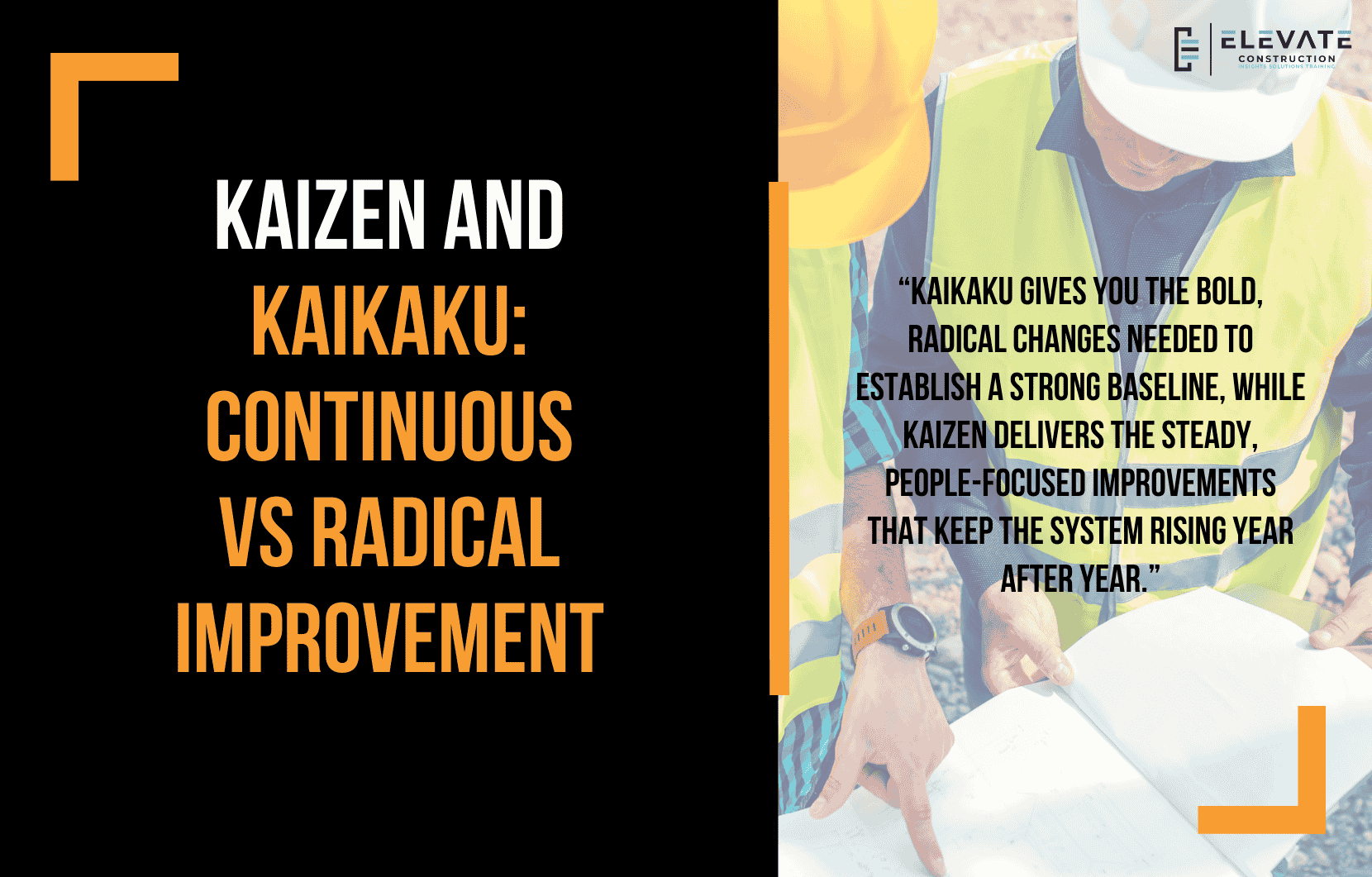Kaizen and Kaikaku: Continuous vs Radical Improvement
In this blog, I want to talk about the heart of Kaizen and how Kaizen and Kaikaku apply directly to construction. These concepts are foundational to creating high-performing teams, stable systems, and long-term improvement.
If you are interested in learning the difference between continuous improvement and radical improvement, stay with me.
What is Kaizen
Kaizen means “to make better.” It is continuous improvement. In the United States, it was often taught as a one-, two-, or three-day workshop, which created a misconception that Kaizen only happens in meetings.
That is not true.
There are two major types of Kaizen:
- Spot Kaizen.
- System or process Kaizen.
Spot Kaizen can happen on the spot, boots on the ground, when someone simply sees something that bugs them and decides to fix it. It can be small, simple, and immediate.
System or process Kaizen is broader. It looks at how a part of the process affects the whole. That is why Taiichi Ohno would ask, “How does this improvement apply to the entire process?”
Kaizen is not just improvement. As the Japanese taught it to me, Kaizen is:
- Love of the customer.
- Pride in the work.
- Acknowledgment of the employees.
If the people on the ground are not acknowledged, the soil is too hard for improvement to take root. Kaizen is the water and fertilizer that prepares the ground.
Spot vs System Kaizen
Spot Kaizen is:
- Fix what bugs you.
- Small, simple improvements made immediately.
System Kaizen is:
- Improvements that affect the entire flow.
- Improvements at the bottleneck, not outside it.
Paul Akers said it well
“There is nothing so wasteful as improving something that should not exist at all.”
Eliyahu Goldratt and his family have reinforced this for years. If your bottleneck is in one location, improving something outside of that zone does not improve the system. It distracts from what actually matters.
An analogy: Seeds, soil, and growth
Mr. Yabe from TESSEI gave us a powerful analogy:
- TPS and Lean are the seeds.
- The people and the company are the ground.
- Kaizen is the water and fertilizer.
If the soil is hard, meaning people are not acknowledged, you cannot grow Lean, TPS, or any meaningful improvement. Acknowledge people first. Improve systems second.
What is Kaikaku
Kaikaku is radical improvement. Big changes. System-level transformations.
Kaikaku looks like:
- Switching out a major piece of equipment.
- Restructuring an entire sequence.
- Implementing a new system.
- Opening a new facility.
- Adopting a new software platform.
Think of Kaikaku as the vertical leap. Kaizen is the steady upward slope.
System implementation vs continuous improvement
Let’s compare different systems on a scale of 0 to 10 for effectiveness and then look at their trajectory.
Examples:
- The Last Planner System might be a 6, but has stayed stagnant.
- CPM might be a 1 and has gotten worse due to abusive behavior.
- The Takt Production System might be an 8, and it keeps climbing.
Toyota may have started around a 6, but continuous improvement pushed it upward for decades.
You must understand two things
- The effectiveness of your system
- The trajectory of your system
A system with upward trajectory beats a stagnant or declining one, even if it starts lower.
Free-market analogy
Consider this analogy:
- US free-market capitalism may be a 60, but trending downward.
- Communism may be a 1, also trending downward.
- Japanese free-market capitalism may be a 62, but trending upward because of how the government manages the system.
Trajectory matters just as much as the starting point.
How Kaizen and Kaikaku apply in construction
This always comes back to the question
“Jason, should we implement fast or slow?”
The answer:
- If your system is not at its minimum functioning level, implement fast. That is Kaikaku.
- Once the baseline is in place, move to steady, people-friendly Kaizen.
Example:
If I walk onto a job that has no Last Planner System, no Takt Production System, and no morning worker huddles, I am not going to tiptoe. I am going to implement morning huddles immediately. We might fail for a couple of weeks, but that radical improvement gets the system to a functioning baseline.
After that, we move into gentle, steady Kaizen improvements.
In Japan, this is normal. The average employee submits 50 – 100 improvement ideas per year. In the US, the average is one to five. We have a lot of room to grow.
Kaizen and Kaikaku together
You need both:
- Kaikaku to launch the system.
- Kaizen to elevate the system.
Continuous improvement keeps the trajectory upward. Radical improvements reset the baseline when needed.
A question for you
Is your system at its minimal functioning composition?
Are there any radical improvements you need to make?
And once the base is in place, are you improving upward?
These questions shape the future of your project, your team, and your company.
I hope you have enjoyed this blog.
If you want to learn more we have:
-Takt Virtual Training: (Click here)
-Check out our Youtube channel for more info: (Click here)
-Listen to the Elevate Construction podcast: (Click here)
-Check out our training programs and certifications: (Click here)
-The Takt Book: (Click here)
Discover Jason’s Expertise:
Meet Jason Schroeder, the driving force behind Elevate Construction IST. As the company’s owner and principal consultant, he’s dedicated to taking construction to new heights. With a wealth of industry experience, he’s crafted the Field Engineer Boot Camp and Superintendent Boot Camp – intensive training programs engineered to cultivate top-tier leaders capable of steering their teams towards success. Jason’s vision? To expand his training initiatives across the nation, empowering construction firms to soar to unprecedented levels of excellence.
On we go

